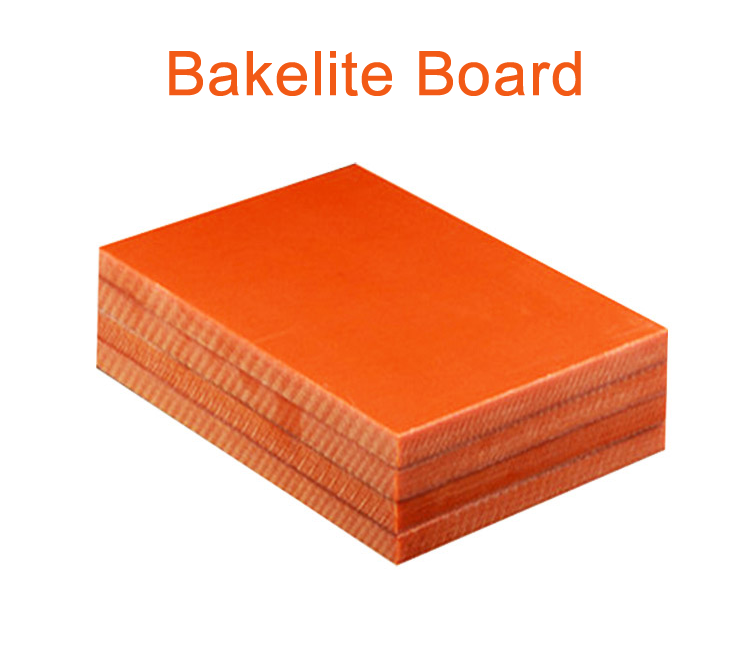Bakelite Board production process and application
Bakelite board is a commonly used insulating material. It is a phenolic laminated board made of bleached wood paddle paper soaked with phenolic resin. It has the characteristics of insulation, no static electricity, wear resistance and high temperature resistance. It plays an important role in the power industry and electronic engineering.

History of Bakelite Board:
Leo Baekeland, a chemist from Belgium, invented the Bakelite sheet. It was a synthetic plastic. It became popular in the electrical industry in 1907.
Baekeland experimented with different combinations of materials. He found that when phenol and formaldehyde mixed. They created a tough and durable material. This new material could withstand high temperatures and was excellent for insulation. He named the new material Bakelite plastic after himself. Then he began producing it in large quantities.
During World War II, it was in high demand for military equipment manufacturing. Such as Bakelite radios, radar systems, and plane components.
The characteristics of bakelite board
First, the bakelite board has excellent insulation properties, which can effectively block the flow of current, so as to play a role in protection and isolation.
Second, the bakelite board also has high mechanical strength and wear resistance. Its surface is hard and smooth and is not easy to be scratched or worn, and can withstand long-term use and external impact. At the same time, the bakelite board also has a low specific gravity and good processing performance, which is easy to cut, drill and process into various shapes. This makes the board more flexible and convenient in the manufacture of insulation and electrical accessories.
Third, the bakelite board has good high temperature resistance. It can maintain stable insulation performance in high temperature environment, and is not easy to melt or deformation. This makes it widely used in power equipment and power tools.
Fourth, the board also has chemical corrosion resistance and can resist the erosion of some common chemicals and solvents. Its surface is smooth and non-absorbent. And it is not easy to be corroded by moisture, acid and alkali and can maintain stable performance in harsh working environments. This makes bakelite board be a reliable and long-lasting insulating material of choice.
Manufacturing of Bakelite Board
Thermosetting synthetic resin is also called the bakelite board. It undergoes a thermosetting process for manufacturing. It produces a firm and long-lasting substance. Its production procedure involves several steps.
Step 1: Mixing of Raw Material
The first step in manufacturing involves the mixing of raw materials in a reactor vessel. Raw materials include phenol, formaldehyde, and fillers such as wood or cotton cloth. A catalyst hydrochloric acid triggers the polymerization reaction while blending. As a result of this reaction, a thermosetting resin is formed.
Step 2: Impregnation of Paper
The next step involves the impregnation of paper with the thermosetting resin. A layer of resin is spread onto the paper and any excess resin is removed by passing it through rollers. The impregnated paper is then dried to remove moisture and prepare it for processing.
Step 3: Lamination
The process of laminating a bakelite board involves arranging several layers of impregnated paper at a right angle to each other. Then, compressing and heating the material produces a hard and inflexible bakelite substance.
Step 4: Curing
The final step in the manufacturing process involves curing. The press subjects the stacked layers of impregnated paper to high temperature and pressure to cure it. This initiates cross-linking in the thermosetting resin. Then the formation of a final product bakelite board becomes completed. This product is a robust, heat-resistant, chemical-resistant material. This material can endure mechanical stress.
The uses of bakelite board
1. Machinery and mold: The bakelite board has high hardness and good wear resistance, so it is often used in the manufacture of fixtures and molds. It is widely used in PCB drilling pad, distribution box, fixture board and other aspects .
2. Electronic products: Bakelite board is often used in the manufacture of electrical components such as switch sockets, fuses, and insulating partitions for power tools and appliances. Its good insulation properties and mechanical strength make it an indispensable material in electrical equipment .
3. Medical and health: Bakelite board can replace metal to make artificial bone, which has the advantages of light weight, non-toxic and strong corrosion resistance, and is widely used in precision medical instruments and artificial bone .
4. Automotive industry: The characteristics of light weight, high mechanical strength, heat resistance, self-lubrication and so on to meet the needs of the automotive industry. Bakelite board is used for the production of various parts, such as bearings, piston rings .
5. Aerospace: Due to the superior comprehensive performance of the bakelite board, it has been widely used in aerospace products abroad and domestic J-8-II aircraft and Shenzhou spacecraft products successfully tried since the 1990s.
Ztelec Group is a professional manufacturer of high-quality electrical insulation materials with more than 60 years of manufacturing experience.
If you need more product information and quotes, please contact us.
- more+releated article
- 2025-12-13G10 and FR4 Epoxy Boards: Commonly Used for Ge
- 2025-12-13Comparison of Heat-Resistant DDP Insulating Pa
- 2025-12-12Price of a 1600kVA 10kV Cast Resin Dry-Type Tr
- 2025-12-12How to Choose Epoxy Laminate Materials for Gen
- 2025-12-11Protection Configuration Principles for 35kV D
- 2025-12-11The Price of Heat-Resistant DDP Insulation Pap
- 2025-12-10Application Prospects of 10kV/35kV Oil-Immerse
- 2025-12-09How to Reduce the Maintenance Cost of Oil-Imme
- 2025-12-09How to Choose the Best 110 kV Oil-Immersed Pow
- 2025-12-08Heat-Resistant DDP Insulation Paper





